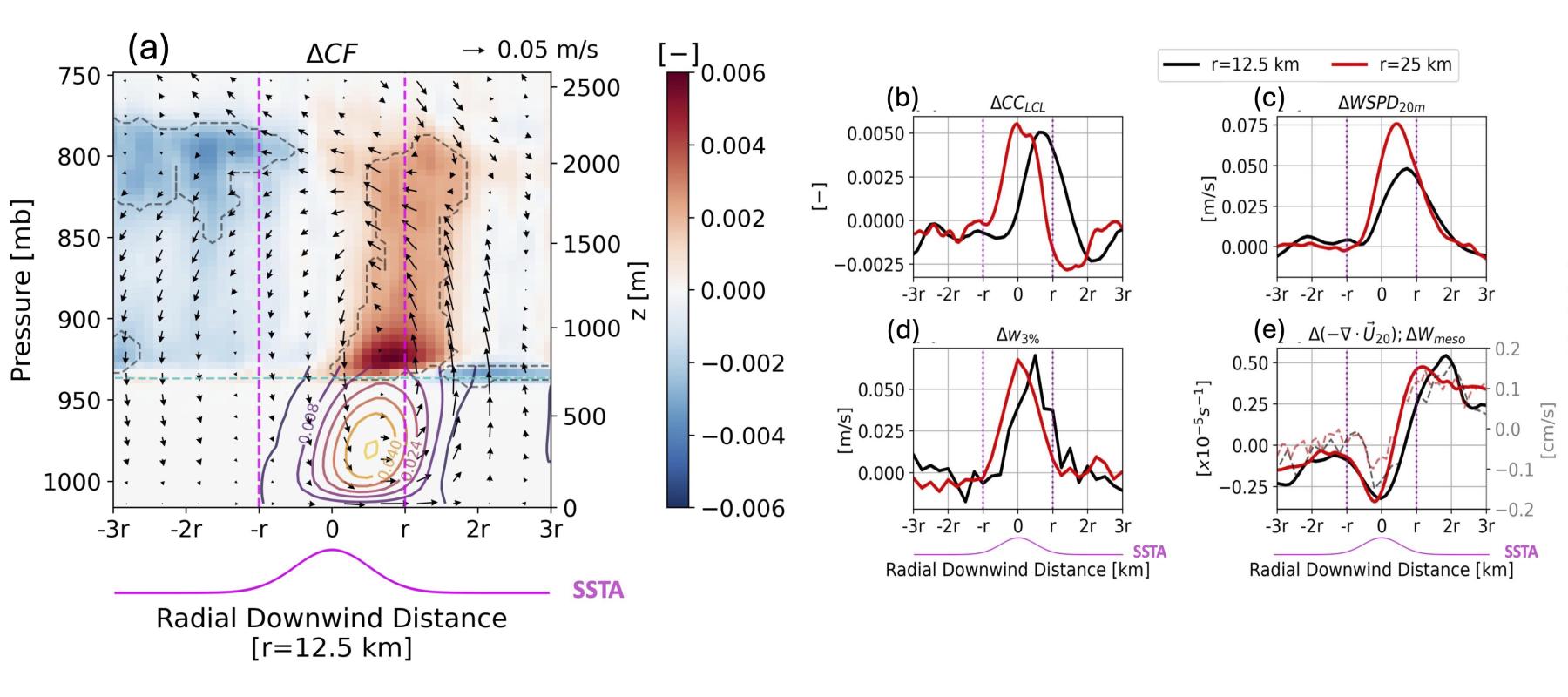Small SST warm anomalies in Tropical Atlantic locally increase trade cumulus formation
Shallow, buoyant clouds in the trade wind environment (trade cumulus) play a key role in Earth’s climate by cooling the planet. How these clouds respond to a warmer world remains a major source of uncertainty for climate models tasked with projecting the future. To address this uncertainty, US and European scientists launched two complementary field campaigns in the winter-time Northwestern Tropical Atlantic in 2020 to quantify how trade cumuli covary with the atmospheric and oceanic environments across a wide range of spatial scales from 10 km to 1000 km.
Using atmospheric Large-Eddy Simulations (LES), Chen et al. (2025) investigated how trade cumuli locally respond to a warm sea surface temperature (SST) anomaly of 0.5°C and 12.5 km radius in the context of the Atlantic Tradewind Ocean-Atmosphere Mesoscale Interaction Campaign (ATOMIC). By comparing 6-hr simulations with and without the prescribed SST anomaly in 16 ensemble members, Chen et al. (2025) found that cloudiness below 1 km is systematically enhanced over the downwind half of the warm SST anomaly (Figure 1a).

Figure 1. (a) Ensemble-mean vertical cross-section of cloud fraction response to a warm SST anomaly averaged between -r and r band in the crosswind direction. Black vectors show the response of secondary circulations. Colored contours show the distribution of vertical velocity variance with an increment of 0.008 m2/s2. (b–e) Comparison of ensemble-mean marine atmospheric boundary layer responses to SST warm anomalies with a 12.5-km (black) and a 25-km (red) radius. Panels b to e show, respectively, near-cloud-base cloud cover, near-surface wind speed, mixed layer averaged upper-third percentile turbulent vertical velocity (convective updraft), and the near-surface wind convergence (solid) with its associated mesoscale ascent averaged in the mixed layer (dashed). Adapted from Figures 6 and 11 of Chen et al. (2025). See full paper for more details and complete captions.
This enhanced low-level cloudiness is generated by enhanced buoyancy-driven turbulence in the subcloud layer and the associated convective updrafts over the warm SST anomaly, as opposed to the SST anomaly-induced surface convergence anomalies and atmospheric mesoscale ascent. The authors argue that locally enhanced convective updrafts lift more surface moisture above the lifting condensation level, leading to more frequent formation of trade cumuli over the SST anomaly and, consequently, an increase in cloudiness near the cloud base. As the radius of the SST anomaly increases from 12.5 km to 25 km, the responses of cloudiness, surface wind, and convergence all shift upwind (Figure 1b–e), making these LES results comparable with satellite composite results during ATOMIC (Chen et al. 2023).
This agreement between LES results and satellite observations in ATOMIC conditions suggests that the observed increase of daily cloud fraction above warm SST anomalies in Chen et al. (2023) is due to more frequent turbulence-driven formation of trade cumuli near the cloud base. The authors deem that climate models can benefit from parameterization improvement to realistically represent the local responses of subcloud turbulent mixing, convective mass flux, and cloud-base cloud fraction to even relatively weak and fine-scale SST anomalies in the tropical oceans.
Chen, X., J. Dias, B. Wolding, P. N. Blossey, C. DeMott, R. Pincus, and E. J. Thompson, 2025: Impacts of weak sea surface temperature warm anomalies on local trade cumulus cloudiness in large eddy simulations. J. Adv. Model Earth Syst., 17, e2024MS004778, https://doi.org/10.1029/2024MS004778.
Topics
- Clouds and Convection
- Process Study
- Air-Sea
- Atlantic Ocean
- Modeling
